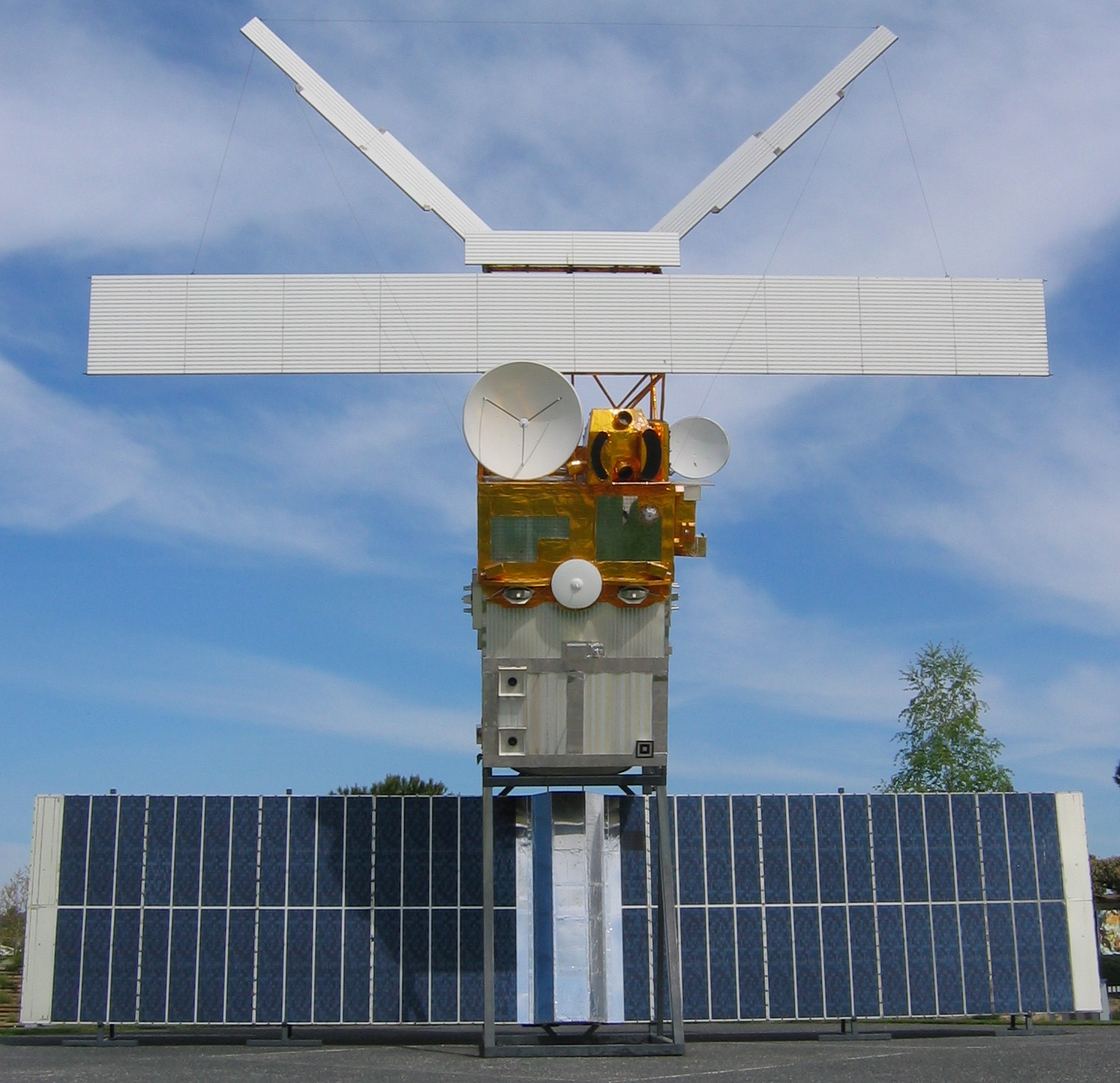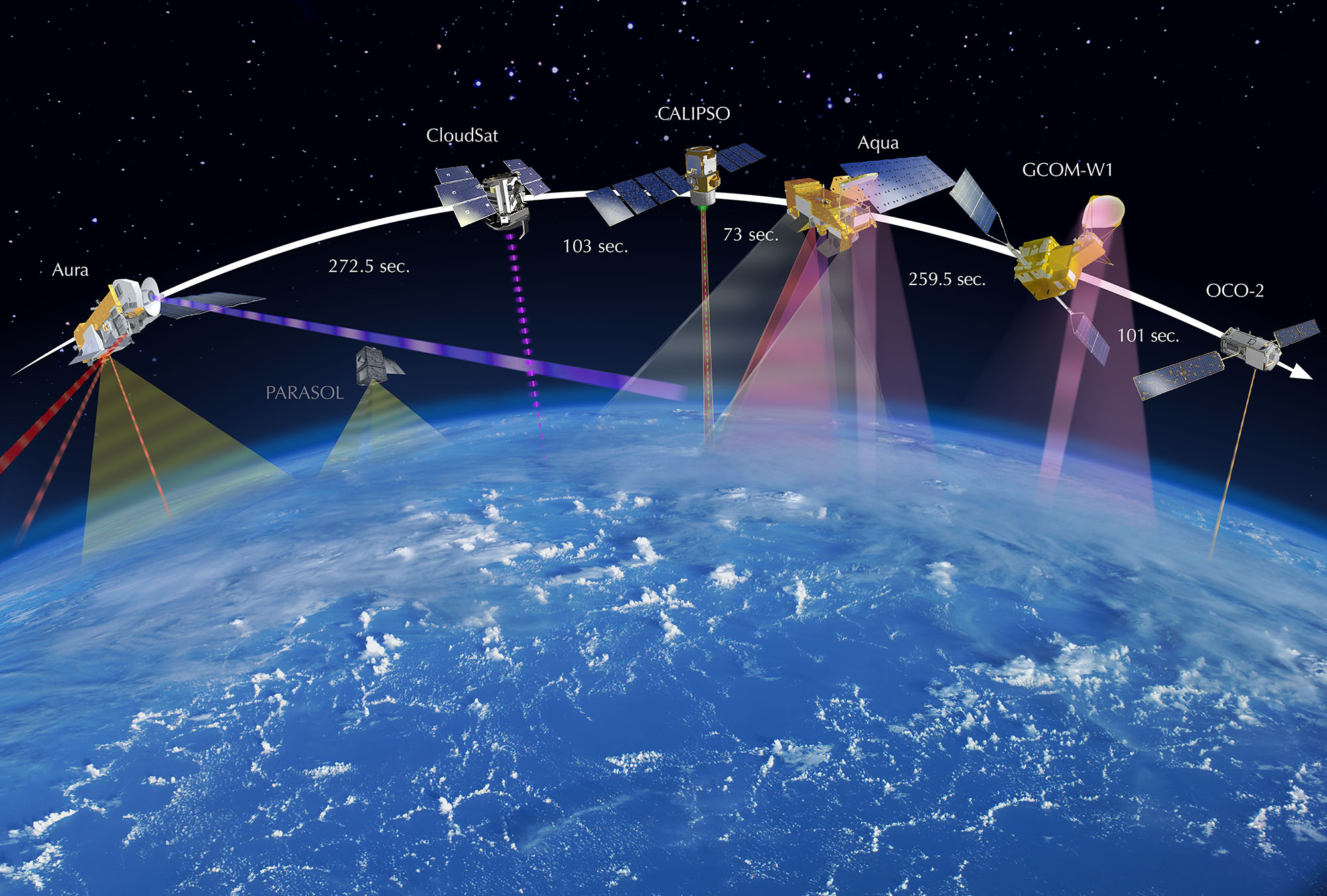|
ERS-1
European Remote Sensing satellite (ERS) was the European Space Agency's first Earth-observing satellite programme using a polar orbit. It consisted of two satellites, ERS-1 and ERS-2, with ERS-1 being launched in 1991. ERS-1 ERS-1 launched 17 July 1991 from Guiana Space Centre aboard an Ariane 4 rocket. The satellite was put into a Sun-synchronous polar orbit at an altitude of 782–785 km. ERS-1 failed on 10 March 2000 after nine years in orbit. Instruments ERS-1 carried an array of Earth-observation instruments that gathered information about the Earth (land, water, ice, and atmosphere) using a variety of measurement principles. These included: * RA (Radar Altimeter) is a single frequency nadir-pointing radar altimeter operating in the Ku band. * ATSR-1 ( Along-Track Scanning Radiometer) is a 4 channel infrared radiometer and microwave sounder for measuring temperatures at the sea-surface and the top of clouds. * SAR (synthetic-aperture radar) operating in C band ... [...More Info...] [...Related Items...] OR: [Wikipedia] [Google] [Baidu] |
AATSR
The Advanced Along Track Scanning Radiometer (AATSR) is one of the Announcement of Opportunity (AO) instruments on board the European Space Agency (ESA)'s Envisat satellite. This instrument is a multi-channel imaging radiometer with the principal objective of providing data concerning global Sea Surface Temperature (SST) to the high levels of accuracy and stability required for monitoring and carrying out research into the behaviour of the Earth’s climate. AATSR can measure Earth's surface temperature to a precision of , for climate research. Among the secondary objectives of AATSR is the observation of environmental parameters such as aerosols, clouds, fires, gas flares, water content, biomass, and vegetal health and growth. AATSR is the successor of ATSR-1 and ATSR-2, payloads of ERS-1 and ERS-2. Details Accuracy The required accuracies are better than 0.3 °C with a stability approaching 0.1 °C /decade. Because of its wide angle lens it is possible to make ver ... [...More Info...] [...Related Items...] OR: [Wikipedia] [Google] [Baidu] |
Sun-synchronous
A Sun-synchronous orbit (SSO), also called a heliosynchronous orbit, is a nearly polar orbit around a planet, in which the satellite passes over any given point of the planet's surface at the same local mean solar time. More technically, it is an orbit arranged so that it precesses through one complete revolution each year, so it always maintains the same relationship with the Sun. Applications A Sun-synchronous orbit is useful for imaging, reconnaissance, and weather satellites, because every time that the satellite is overhead, the surface illumination angle on the planet underneath it is nearly the same. This consistent lighting is a useful characteristic for satellites that image the Earth's surface in visible or infrared wavelengths, such as weather and spy satellites, and for other remote-sensing satellites, such as those carrying ocean and atmospheric remote-sensing instruments that require sunlight. For example, a satellite in Sun-synchronous orbit might ascend acro ... [...More Info...] [...Related Items...] OR: [Wikipedia] [Google] [Baidu] |
Scatterometer
A scatterometer or diffusionmeter is a scientific instrument to measure the return of a beam of light or radar waves scattered by diffusion in a medium such as air. Diffusionmeters using visible light are found in airports or along roads to measure horizontal visibility. Radar scatterometers use radio or microwaves to determine the normalized radar cross section (σ0, "sigma zero" or "sigma naught") of a surface. They are often mounted on weather satellites to find wind speed and direction, and are used in industries to analyze the roughness of surfaces. Optical Optical diffusionmeters are devices used in meteorology to find the optical range or the horizontal visibility. They consist of a light source, usually a laser, and a receiver. Both are placed at a 35° angle downward, aimed at a common area. Lateral scattering by the air along the light beam is quantified as an attenuation coefficient. Any departure from the clear air extinction coefficient (e.g. in fog) is measured a ... [...More Info...] [...Related Items...] OR: [Wikipedia] [Google] [Baidu] |
Earth Observation Satellite
An Earth observation satellite or Earth remote sensing satellite is a satellite used or designed for Earth observation (EO) from orbit, including spy satellites and similar ones intended for non-military uses such as environmental monitoring, meteorology, cartography and others. The most common type are Earth imaging satellites, that take satellite images, analogous to aerial photographs; some EO satellites may perform remote sensing without forming pictures, such as in GNSS radio occultation. The first occurrence of satellite remote sensing can be dated to the launch of the first artificial satellite, Sputnik 1, by the Soviet Union on October 4, 1957. Sputnik 1 sent back radio signals, which scientists used to study the ionosphere. The United States Army Ballistic Missile Agency launched the first American satellite, Explorer 1, for NASA's Jet Propulsion Laboratory on January 31, 1958. The information sent back from its radiation detector led to the discovery of the Earth's Van ... [...More Info...] [...Related Items...] OR: [Wikipedia] [Google] [Baidu] |
Guiana Space Centre
The Guiana Space Centre (; CSG), also called Europe's Spaceport, is a spaceport to the northwest of Kourou in French Guiana, an Overseas departments and regions of France, overseas region of France in South America. Kourou is located approximately north of the equator at a latitude of 5°. In operation since 1968, it is a suitable location for a spaceport because of its near equatorial location and open sea to the east and north. At CSG, space launches are conducted by several European private companies and government agencies working together. The CSG land itself is managed by CNES, the French national space agency. The launch infrastructure built on the CSG land is owned by the European Space Agency. The private company Arianespace operates the launches including planning missions, handling customer relationships and overseeing the team at CSG that integrates and prepares vehicles for launch. The rockets themselves are designed and produced by other companies, ArianeGroup f ... [...More Info...] [...Related Items...] OR: [Wikipedia] [Google] [Baidu] |
Laser
A laser is a device that emits light through a process of optical amplification based on the stimulated emission of electromagnetic radiation. The word ''laser'' originated as an acronym for light amplification by stimulated emission of radiation. The first laser was built in 1960 by Theodore Maiman at Hughes Research Laboratories, based on theoretical work by Charles H. Townes and Arthur Leonard Schawlow and the optical amplifier patented by Gordon Gould. A laser differs from other sources of light in that it emits light that is coherence (physics), ''coherent''. Spatial coherence allows a laser to be focused to a tight spot, enabling uses such as optical communication, laser cutting, and Photolithography#Light sources, lithography. It also allows a laser beam to stay narrow over great distances (collimated light, collimation), used in laser pointers, lidar, and free-space optical communication. Lasers can also have high temporal coherence, which permits them to emit light ... [...More Info...] [...Related Items...] OR: [Wikipedia] [Google] [Baidu] |
Retroreflector
A retroreflector (sometimes called a retroflector or cataphote) is a device or surface that reflects light or other radiation back to its source with minimum scattering. This works at a wide range of angle of incidence (optics), angle of incidence, unlike a planar mirror, which does this only if the mirror is exactly perpendicular to the wave front, having a zero angle of incidence. Being directed, the retroflector's reflection (physics), reflection is brighter than that of a diffuse reflector. Corner reflectors and Cat's eye (road), cat's eye reflectors are the most used kinds. Types There are several ways to obtain retroreflection: Corner reflector A set of three mutually perpendicular reflective surfaces, placed to form the internal corner of a cube, work as a retroreflector. The three corresponding normal vectors of the corner's sides form a basis in which to represent the direction of an arbitrary incoming ray, . When the ray reflects from the first side, say x, the ray' ... [...More Info...] [...Related Items...] OR: [Wikipedia] [Google] [Baidu] |
Radiation Hardening
Radiation hardening is the process of making electronic components and circuits resistant to damage or malfunction caused by high levels of ionizing radiation (particle radiation and high-energy electromagnetic radiation), especially for environments in outer space (especially beyond low Earth orbit), around nuclear reactors and particle accelerators, or during nuclear accidents or nuclear warfare. Most Semiconductor device, semiconductor electronic components are susceptible to radiation damage, and radiation-hardened (rad-hard) components are based on their non-hardened equivalents, with some design and manufacturing variations that reduce the susceptibility to radiation damage. Due to the low demand and the extensive development and testing required to produce a radiation-tolerant design of a microelectronics, microelectronic chip, the technology of radiation-hardened chips tends to lag behind the most recent developments. They also typically cost more than their commercial cou ... [...More Info...] [...Related Items...] OR: [Wikipedia] [Google] [Baidu] |
Radar Altimeter
A radar altimeter (RA), also called a radio altimeter (RALT), electronic altimeter, reflection altimeter, or low-range radio altimeter (LRRA), measures altitude above the terrain presently beneath an aircraft or spacecraft by timing how long it takes a beam of radio waves to travel to ground, reflect, and return to the craft. This type of altimeter provides the distance between the antenna and the ground directly below it, in contrast to a barometric altimeter which provides the distance above a defined vertical datum, usually mean sea level. Principle As the name implies, radar (radio detection and ranging) is the underpinning principle of the system. The system transmits radio waves down to the ground and measures the time it takes them to be reflected back up to the aircraft. The altitude above the ground is calculated from the radio waves' travel time and the speed of light. Radar altimeters required a simple system for measuring the time-of-flight that could be displayed ... [...More Info...] [...Related Items...] OR: [Wikipedia] [Google] [Baidu] |
Spacecraft Attitude Control
Spacecraft attitude control is the process of controlling the orientation of a spacecraft (vehicle or satellite) with respect to an inertial frame of reference or another entity such as the celestial sphere, certain fields, and nearby objects, etc. Controlling vehicle attitude requires actuators to apply the torques needed to orient the vehicle to a desired attitude, and algorithms to command the actuators based on the current attitude and specification of a desired attitude. Before and during attitude control can be performed, spacecraft attitude determination must be performed, which requires sensors for absolute or relative measurement. The broader integrated field that studies the combination of sensors, actuators and algorithms is called ''guidance, navigation and control'', which also involves non-attitude concepts, such as position determination and navigation. Motivation A spacecraft's attitude must typically be stabilized and controlled for a variety of reasons. It ... [...More Info...] [...Related Items...] OR: [Wikipedia] [Google] [Baidu] |
Bathymetry
Bathymetry (; ) is the study of underwater depth of ocean floors ('' seabed topography''), river floors, or lake floors. In other words, bathymetry is the underwater equivalent to hypsometry or topography. The first recorded evidence of water depth measurements are from Ancient Egypt over 3000 years ago. Bathymetry has various uses including the production of bathymetric charts to guide vessels and identify underwater hazards, the study of marine life near the floor of water bodies, coastline analysis and ocean dynamics, including predicting currents and tides. Bathymetric charts (not to be confused with '' hydrographic charts''), are typically produced to support safety of surface or sub-surface navigation, and usually show seafloor relief or terrain as contour lines (called '' depth contours'' or '' isobaths'') and selected depths ('' soundings''), and typically also provide surface navigational information. Bathymetric maps (a more general term where navigational safet ... [...More Info...] [...Related Items...] OR: [Wikipedia] [Google] [Baidu] |






